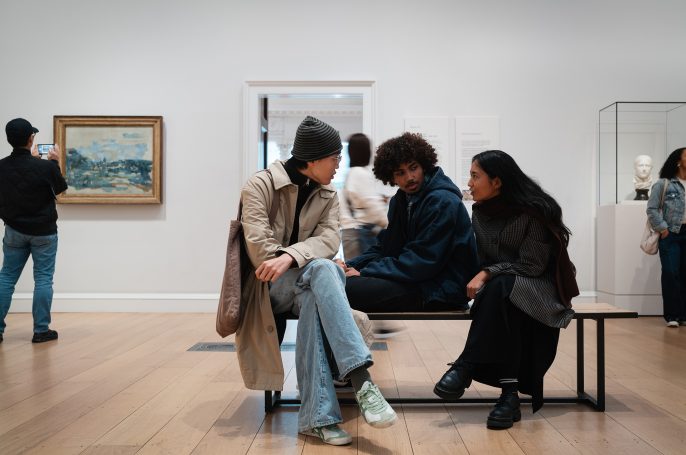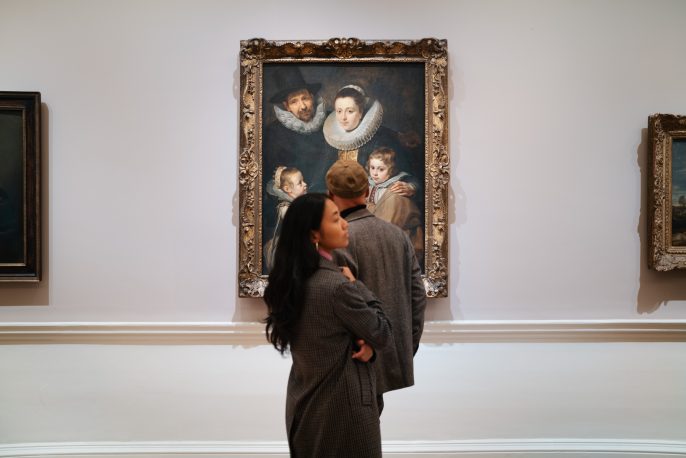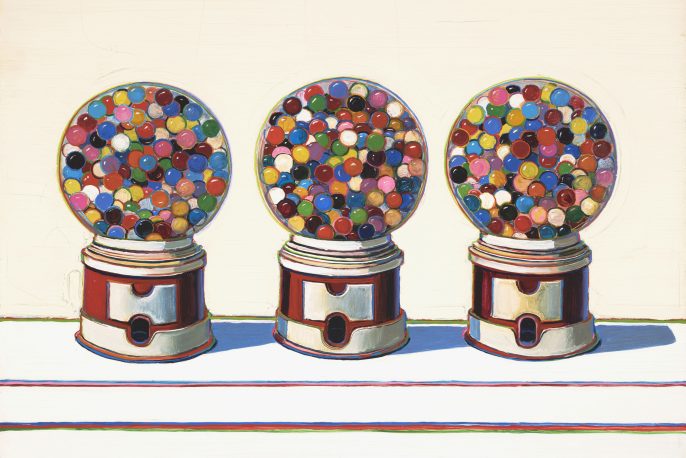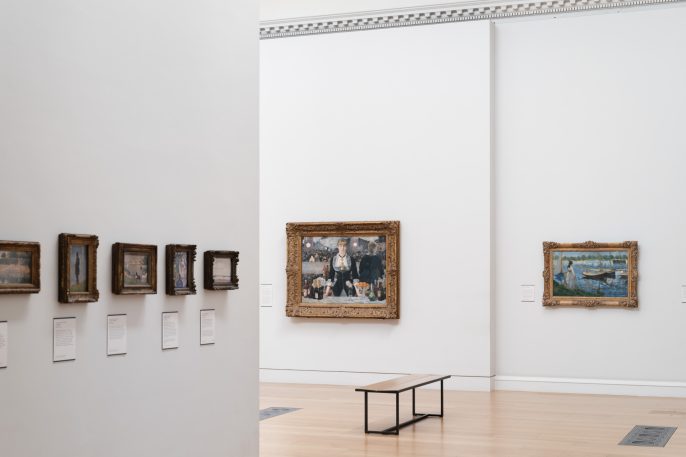In January 1476, at the request of the Condestable Pedro Fernández de Velasco, and the Duke of Villahermosa, Isabella I of Castile travelled from Valladolid to Burgos to oversee the triumphant recovery of the city’s castle. She encountered a devastated city. The city had been transformed into a battlefield since the rebellion of Álvaro de Zúñiga in May 1475 and the ensuing siege on the castle by troops loyal to Isabella and Ferdinand of Aragon.[1] During her stay, as Hernán del Pulgar relates, Isabella dedicated herself to the reorganisation of the local political and military power structures as well as the reconstruction of the castle.[2]
Although there is no record of a visit by Isabella to the Carthusian monastery of Santa María de Miraflores at that time, it seems that the queen somehow became aware of the dilapidated state of the unfinished funerary church of her father, King John II, following twelve years of standstill at the site (Fig. 9.1).[3] Isabella remained in the city until 5 February, probably visiting the monastery to pay homage to her father, just as Ferdinand did when he came to Burgos in June 1475.[4] Be as that may, two months after Isabella’s stay in Burgos, when victory at the battle of Toro had assured her the Castilian crown, all royal privileges to the Carthusian monastery were confirmed.[5] One year later, in February 1477, a ceremony was held to lay the foundation stone of new work in the church of Miraflores.[6]

According to the author(s) of the Breve noticia de la fundacion de la Real Cartuja de Miraflores, drafted under prior Manuel de Aldea (1780–1789), it was Isabella who ordered the resumption of construction.[7] This claim has consistently been repeated in subsequent studies, though it is entirely unsupported by documentary evidence.[8] It is in fact unclear whether it was Isabella or the Carthusian community that ordered the resumption of construction. Lacking a proper church, the Carthusians had been using the refectory for liturgical celebrations since 1460.[9] If it was the queen that ordered the works, it seems that her order was not accompanied at that time by direct financial support.[10] Although the Cortes celebrated at Segovia and Madrigal in April 1476 offered Isabella a budget of 168,000,000 maravedis, the economic situation of the Castilian crown was fragile.[11] Allocating resources was one thing, paying hard cash was quite another. The expenses of the conflict in Burgos alone were estimated to be 34,560,000 maravedis.[12]
An Unsuccessful Resumption of Works: Garci Fernández at Miraflores
In February 1477, when construction reportedly resumed, work was carried out under the direction of Garci Fernández de Matienzo. According to the Fundacion de la Cartuja de Burgos and to the Cartuja de Miraflores, drafted in the last third of the eighteen century, Garci Fernández was appointed master of works because of the death of Juan de Colonia, the renowned German architect who began construction of the monastery in the 1450s.[13] By these accounts, Garci Fernández was thus appointed while logistical reorganisation of the project was developing. Whatever the case, Garci died on 10 February 1478,[14] and so any attribution of works to Garci Fernández is highly questionable. The chronicles that assert this are also contradictory. According to one version, the walls of the church were completed in their entirety under Garci’s direction and he also oversaw the closing of presbytery vaults.[15] According to a second version, only the walls were built under Garci.[16] This second version has been widely accepted by scholars.[17] But analysis of the construction of Miraflores casts doubt on the completion of the walls in 1477. Hereafter, I will focus on three issues.
Firstly, we must take into account that in the mid-1460s, when construction of the church stalled, the walls had been raised up to different heights. According to a description of the church, recorded in the Noticia vreve and probably extracted from a report similar to the famous Memorial del plan y obras,[18] the north wall stood at twenty feet high and the south wall at thirty-six and a half feet.[19] Furthermore, given the joint structure of masonry at the junctions of the buttresses and walls, we can deduce that the buttresses were built in the 1460s, before the walls.[20] Indeed, given that funding problems caused construction of the church to stall, it is likely that the buttresses had been built to a higher level than the walls. Archaeological remains of this common constructive strategy are preserved, for instance, at Astorga Cathedral (Fig. 9.2) and at Seville Cathedral, both buildings related to the Colonia dynasty.[21]

Second, it is important to recognise that winters in Burgos are too cold to set mortar safely. Assuming that funds were ready, the workshop organised, and the supply of materials ensured, stonecutting might conceivably have started in 1476. Even if this were the case, it is unlikely that the building process was underway before the spring and summer of 1477, ‘quando est tempus edificandi’, as the bishop of Burgos, Alonso de Santa María (himself a great patron and connoisseur of architecture), reminds us in his will.[22] It is also unlikely that the building process was underway in the winter of 1477/8.
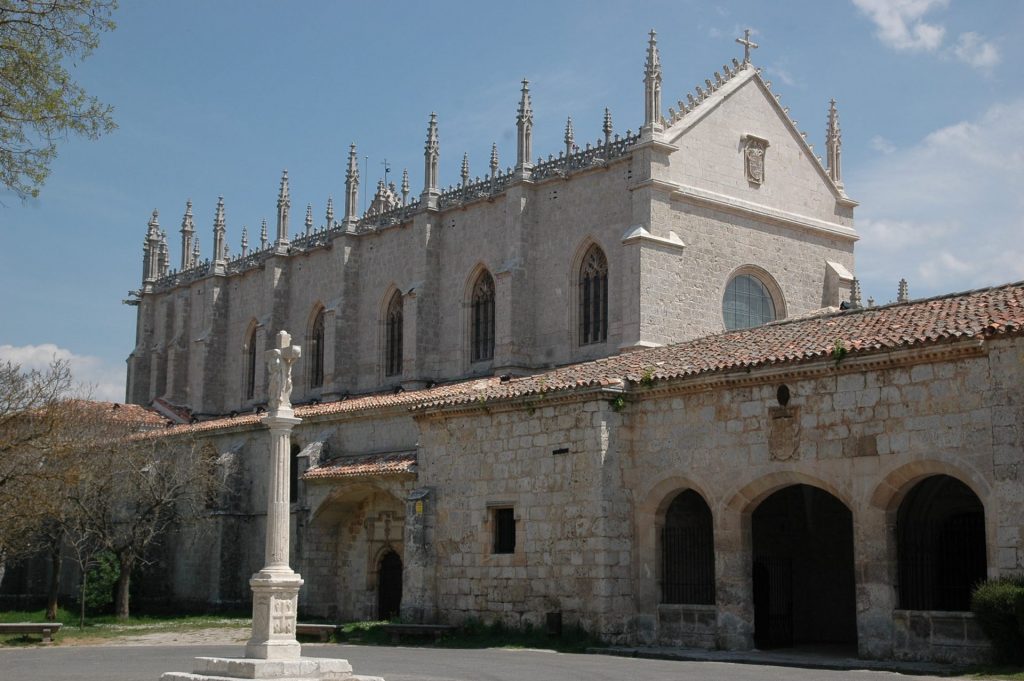
Third, there is strong evidence that the walls of the church were still under construction in summer 1484. In June, the angel holding Isabella and Ferdinand’s coat of arms was installed on the west façade, as well as a crucifix on the top of the pediment (Fig. 9.3).[23] A year later, the installation of the window tracery was still ongoing.[24] We can thus assume that the stained glass was not commissioned until that moment, at least for the nave windows.[25] These three pieces of evidence suggest that little was built in the church until the 1480s. More precisely, it was under Prior Juan Temiño (1483–1487) that we can trace the building process more closely and also assess Isabella’s active role in the project.
A New Building Programme under Isabella’s Patronage
After the civil war, Isabella’s personal and political dedication to endowing her father with a sumptuous burial place led her to go beyond the funerary dispositions of John II.[26] Under Isabella, the church at Miraflores was conceived as the pantheon for a new constellation of royal bodies, namely the first-degree members of Isabella’s family. Besides John II, it was to house the tombs of Isabella’s mother and brother: Queen Isabella of Portugal (John’s second wife) and the infante Alfonso. Petrified in alabaster, the tombs would have made tangible—in space and until the end of time—the restored prestige of the Castilian royal family (Fig. 9.4).[27] The tombs also implied that Isabella belonged to an unbroken line of Castilian monarchs.


Architecture was implicated in this new scheme, and Simón de Colonia was the architect responsible for it.[28] Indeed, despite the claims of the Carthusian authors of the Miraflores chronicles (or the scholars who have paraphrased them), Juan de Colonia’s original architectural drawings for Miraflores were revised and it was decided to redesign the project as well as expand it.[29] This is clear not only from the plans for a narthex and new main portal, originally installed on the north side of the narthex (Figs. 9.5 and 9.10),[30] but also from the fragment of a parchment drawing with six different designs or proposals for the resolution of the clearstory and the vaults of the church (Fig. 9.6).[31] In fact, everything suggests that the ascetic character of the church designed by Juan de Colonia did not fulfil the queen’s expectations of the architectonical decorum and magnificence appropriate for a royal foundation. In order to understand this issue, we must go back to the 1450s, when the building of the charterhouse of Miraflores was first conceived.[32]

As originally planned, John II wanted to convert the palace of Miraflores into a Carthusian monastery by reforming the existing building and expanding it with the construction of his burial church. Because this plan was rejected by the Carthusian Order, the king promised to build a new monastery outside the palace’s walls.[33] Nevertheless, John II’s original plan was not abandoned until October 1452, when the palace was destroyed by fire. It was then that the Carthusian community, which had gained major decision-making capacity, developed a building programme ‘al modo de la dicha horden’, devised by Juan de Colonia. The institutional and personal relations between Miraflores and the Sevillan charterhouse of Santa María de las Cuevas played a key role in this, as witnessed by the selection of architectural models derived from the Sevillan charterhouse for the construction of the new foundation.[34] These included the church (Fig. 9.7). As recorded in the Memorial del plan y obras, the church was to be built in ‘la forma de la yglesia que fiso el adelantado pedro afán de Ribera en las cuevas de sevilla’.[35] Given that John II never visited Seville,[36] the king could only have known about Santa María de las Cuevas from architectural drawings.[37] That is to say that he could have only seen the archetype—as suggested in the Memorial—elected and proposed by the Carthusians.


As the church at Miraflores shows, Juan de Colonia closely imitated the design of Santa María de las Cuevas, adopting not only its plan but also its architectural language (see Figs. 9.1 and 9.7). This can be seen, for example, in the design for the original main portal of Miraflores (Fig. 9.8), effectively an architectural paraphrase of that at Las Cuevas (Fig. 9.9). According to the ascetic aesthetics of the Carthusian order, neither heraldic emblems nor sculpture decorate Miraflores’s portal. Its design is reduced to architectural forms. Simón de Colonia’s portal suggests, however, that Isabella and her deputies considered the aniconism and lack of heraldry in Juan’s portal to be inappropriate for a royal foundation.


Comparing the original main portal with the new one (Figs. 9.8 and 9.10), it is easy to identify the paradigm shift between Juan de Colonia’s models and stylistic parameters adopted by his son three decades later. Rejecting his father’s ascetic abstraction, Simón employed the same formal repertoire that he used in contemporary buildings in Burgos Cathedral, such as the chapel of La Concepción or the chapel of the Constable, and later in parish churches such as San Nicolás in Burgos, where the main portal follows that at Miraflores.
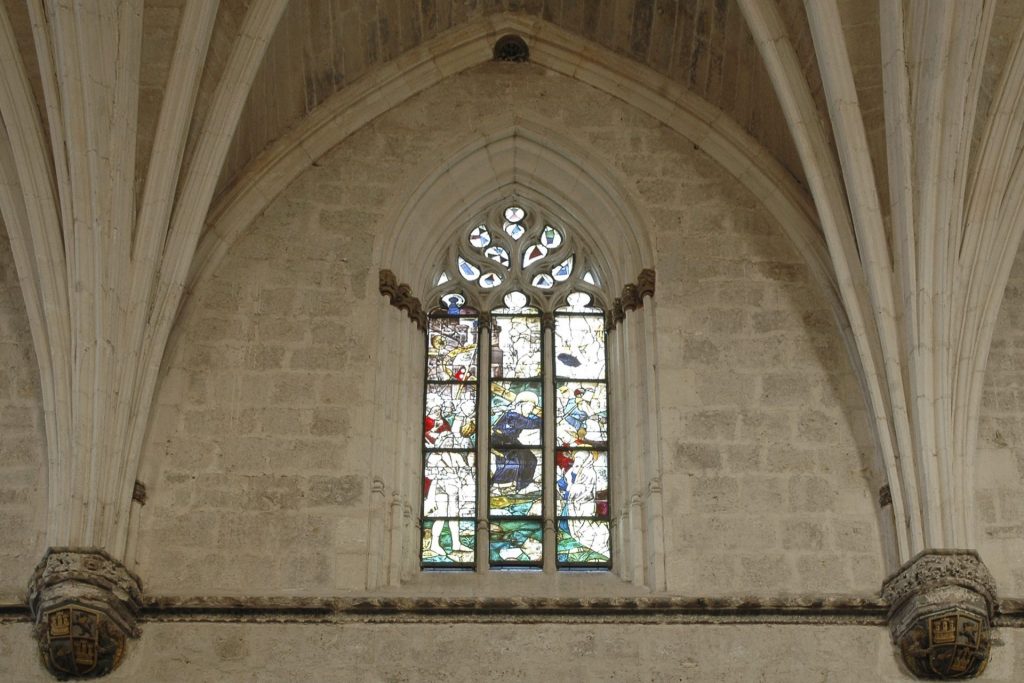

The clearstory and vault plan of Miraflores clearly show this new architectural orientation. The three-light windows of Miraflores and the Constable’s Chapel display the same basic design, as well as similar tracery designs, mouldings, capitals and bases (Figs. 9.11 and 9.12).[38] By contrast, the capitals on the formerets seem to go back to the elevation devised by Juan de Colonia. The same configuration appears earlier in the choir of San Pedro de Cardeña.[39] In the same way, Simón de Colonia retained his father’s design for the vault of the capilla mayor, which follows that at Santa María de las Cuevas.[40] The young architect nonetheless introduced new designs in the nave vault that are much more elaborate than those in the nave of Las Cuevas (see Figs 9.5 and 9.7).[41] They share only one feature: the ridge-rib.
Monumental Scenography: Architecture in Space
Unlike the project of the 1450s, the creation of an impressive external view for the church played a pivotal role in the new building programme. As discussed Miraflores became a monument to the Castilian monarchy under Isabella’s patronage, placing the queen in an unbroken dynastic line even if this status could not easily be proclaimed, given the church’s location in a Carthusian monastery three kilometres from Burgos, visited by few and partly veiled from sight.
Simón’s design did not start ex nihilo. As noted above, the church’s walls rose several metres above ground and the main portal was already installed on the west façade (see Figs. 9.1 and 9.8). Not only was the portal considered inappropriate, but so too was Juan de Colonia’s façade, which also imitated Las Cuevas. Construction of a new narthex solved these problems (see Fig. 9.5), making it possible to carve a new portal to be placed to the north side of the narthex. The monumentality of the church’s north façade was thereby enhanced, effectively becoming the church’s main façade.
In order to understand Simón de Colonia’s design, we have to take into account the position of the church within the monastery, as well as the topography of the leafy parkland around Miraflores. Simón had known the monastery and its surroundings since childhood, so was fully aware that those coming to Miraflores would travel along the so-called camino de Burgos. Likewise, the young architect knew that the first visual contact with the church would be from the northwest.

Although there is no documentary evidence about this precise stretch of the camino de Burgos at the end of the fifteenth century, it cannot have been very different from what is now known as the Camino de la Paz (Fig. 9.13). This provided the main access to the monastery until the construction of a paved road and seems to correspond to the route of the camino de Burgos represented in several maps and descriptions of the Miraflores parkland from the eighteenth century (Fig. 9.14).[42] At that time, points of entry were opened in what remained of the boundary. Built in the time of Enrique III, the founder of the old palace of Miraflores, the Puerta Real—later known as La Vieja—provided the main entrance to the Miraflores estate from the camino de Burgos.[43] Two other entries were provided for the roads from Cardeña and Cardeñadillo.
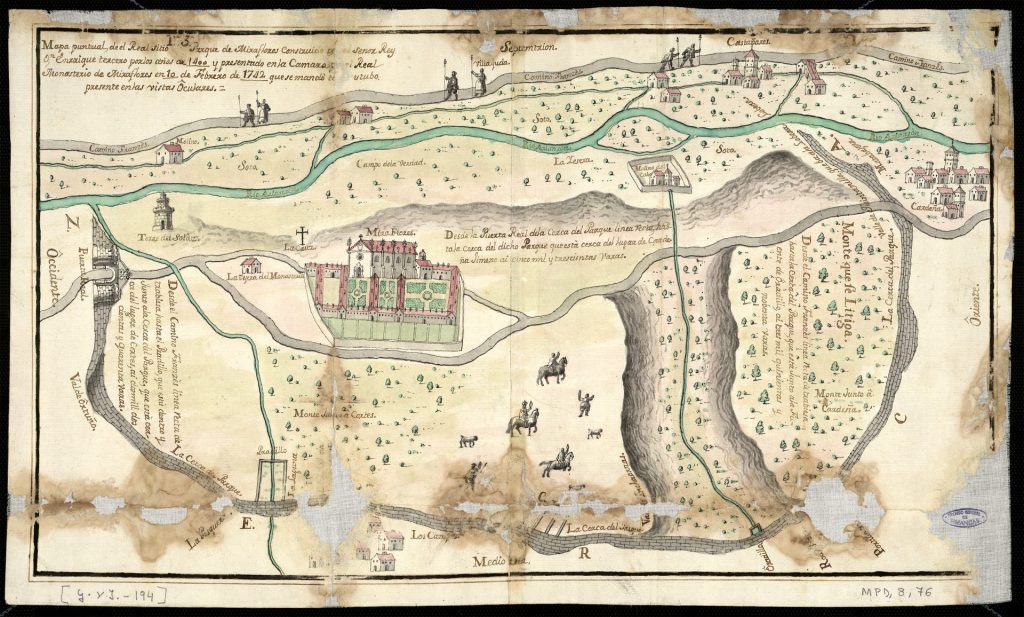

Shaping Architectural Spaces
Simón de Colonia’s project embraced not just an update of Juan de Colonia’s architectural vocabulary, but also spatial redefinition. In addition to the relocation of the main portal on the church’s north side, the construction of the narthex itself implied the creation of an antechamber that was open to the faithful. Unlike the direct access devised by Juan de Colonia, the narthex displays a transitional architectural space that connects the exterior and the interior of the church. Whether intentionally or not, the narthex influenced and still influences the visitor’s perception of the church’s architectural space. Crossing the main portal, the faithful entered, as now, a space covered by a tierceron vault and scarcely lit by a small rose, originally on the west side of the narthex.[45] Alternating in each corner, the emblems of the Order of the Band and Castile decorate the shafts, referring again to the monastery’s founder. Crossing the church portal from darkness of the narthex, visitors enter a space that is dramatically larger and bright, during daylight hours at least (see Fig. 9.9). A similar effect has been observed in the old chapel of San Pedro that precedes the Constable’s Chapel in Burgos Cathedral, though this may have been prompted by other factors.[46]
In Miraflores, beyond the old church portal, the space opened to the faithful was the westernmost bay of the church.[47] This space is separate from the lay brother’s choir by a grille. The current iron grille was installed in the nineteenth century, although the original grille, ‘la reja grande’, was also iron.[48] Installed in 1493, the original grille was decorated with the royal coats of arms and, very likely, two sculptures of angels by Gil de Siloe.[49] Nowadays, if the screen is closed, the beholder can hardly see the royal tombs from the west end of the church, and this seems to have been the case at the end of the fifteenth century. Placed below the exuberant presbytery vault and before the richly carved retable, the tomb of John II and Isabella of Portugal is more than 31.5 metres from the grille. Observed from the west bay, only its pale profile can be perceived (Fig. 9.16).

Analysis of the interior suggests that Simón de Colonia was fully aware of this situation when he conceived the inner elevations. Unlike the nave vaults, the ribs of the presbytery vault are decorated with delicate tracery (Fig. 9.17). Simón de Colonia had used the same feature to decorate the ribs of the Conception Chapel in Burgos Cathedral, as well as the arch separating the Constable’s Chapel from chapel of San Pedro. Although this form has been associated with a dubiously semantic load, it seems to be no more than a decorative device that enhanced the richness of the vaults. What is noteworthy is not Simón’s use of this vocabulary, but rather its manipulation to create different aesthetic effects depending on the standpoint of the beholder. I will illustrate this point by comparing the vaults at Miraflores with this in the Conception Chapel in Burgos Cathedral.
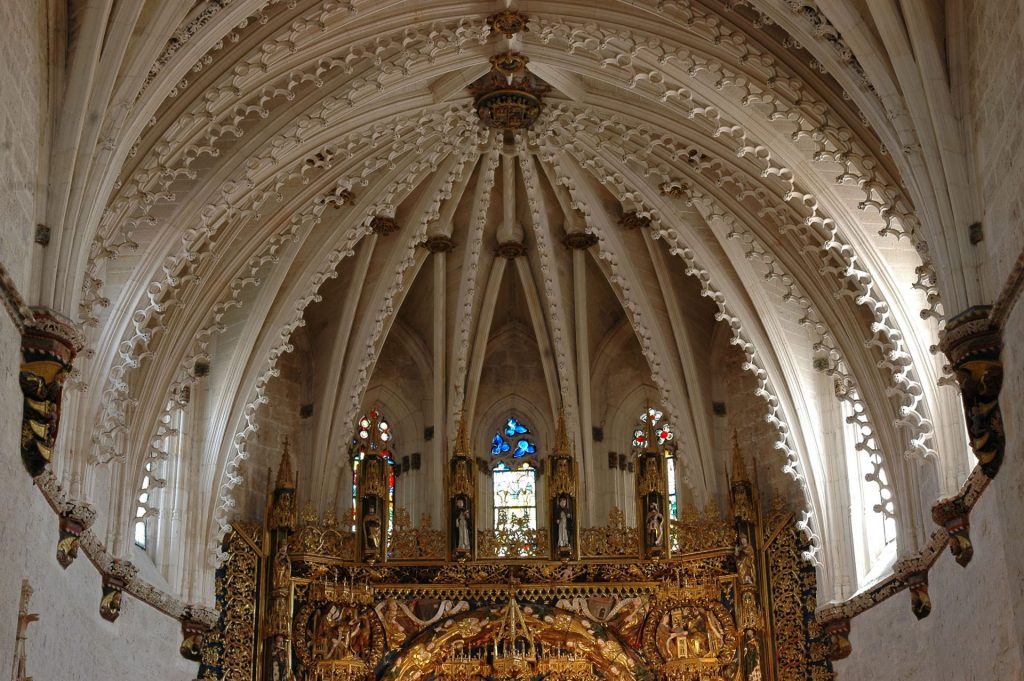
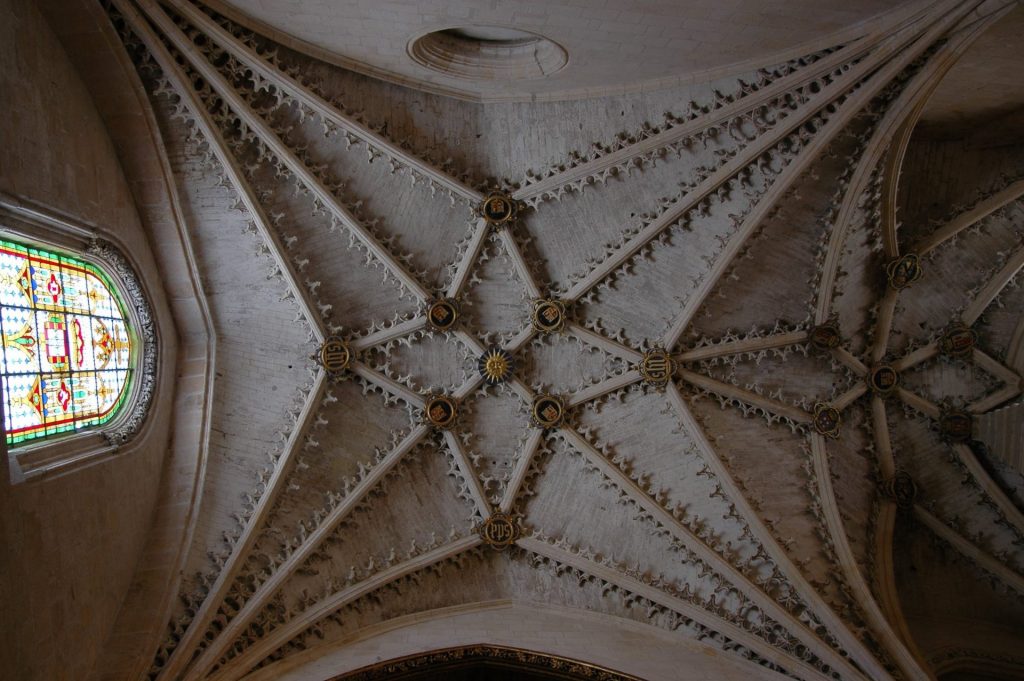
In the vault of the Conception Chapel, the tracery springs from the lateral sides of the ribs, creating a delicate border along their entire length. Observed from the interior of the chapel, the ribs resemble a dynamic floating structure, detached from the vault webs (Fig. 9. 18). The drama of this illusion is increased by delicate polychromy. Below the webs, which were probably painted in blue, the ribs were painted in gold, remnants of which are still visible. In Miraflores, on the contrary, the tracery work hangs from the intrados of the main ribs of presbytery vault and from the transverse arch separating the capilla mayor from the nave (see Fig. 9.17). The tracery visualises the spatial division between the presbytery and the nave, in accordance with the decorum of both spaces. As the church has only a single nave, this formal variation was one of the few means available to Simón to differentiate the two spaces.
Comparing both vaults, we can conclude that the Conception Chapel’s vault was conceived to be observed from below, within the chapel. But the vaults of the capilla mayor at Miraflores were to be observed obliquely, particularly from the westernmost bay of the nave. By examining the design procedures and creative strategies codified in the parchment fragment from Miraflores, I will show how Simón carefully considered the church’s spatial organisation when designing the vaults.
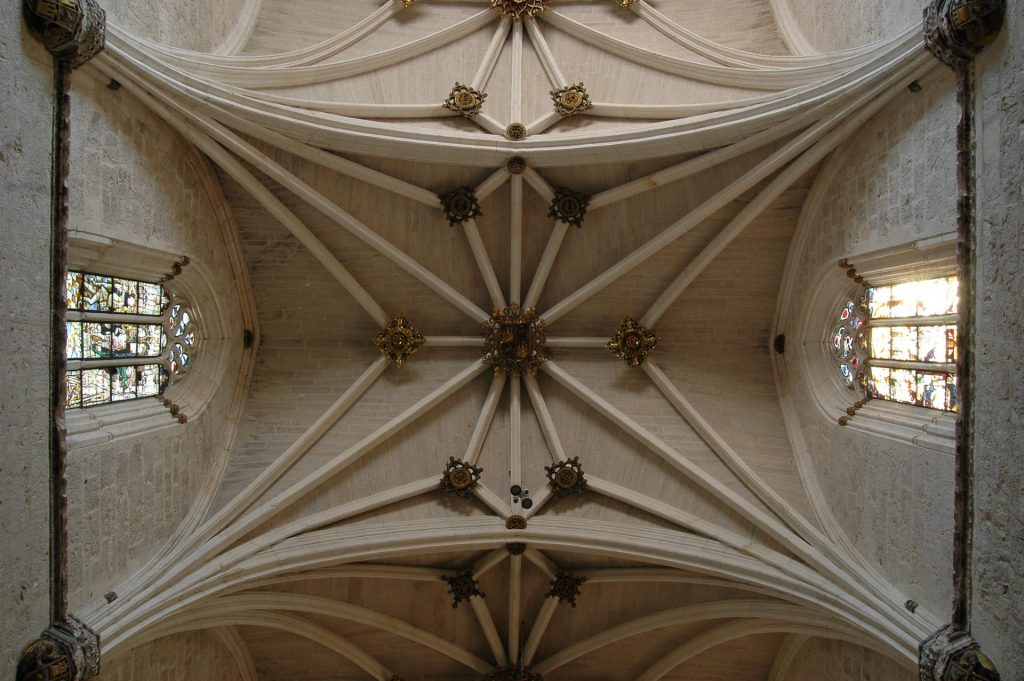
Like the vaults drawn on the parchment fragment, the vault of the church at Miraflores includes a ridge rib (see Figs. 9.5 and 9.6). This seems to have been planned by Juan de Colonia, following the vault plan of Las Cuevas (see Fig. 9.7). In the vaults of the four western bays of the nave, the ridge rib and diagonal ribs form six compartments, which are subdivided by tiercerons (the transversal compartments) and triradials (the longitudinal compartments) (Figs. 9.19 and 9.21). The vault of the eastern bay includes an extra transverse rib, creating eight compartments, each articulated by triradials (Figs. 9.20 and 9.21). One might think that Simón wanted to emphasise spatial differentiation in the nave, but as originally planned, the monks’ choir was and is located in the two eastern bays.[50] That is to say that both bays constitute a unified space from a functional point of view.
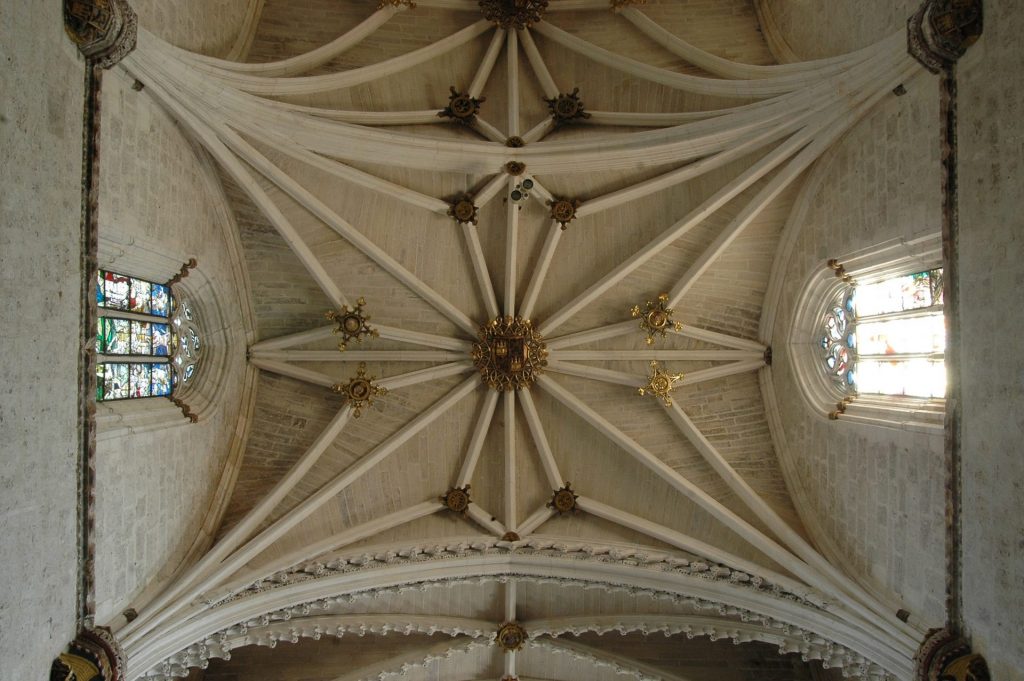
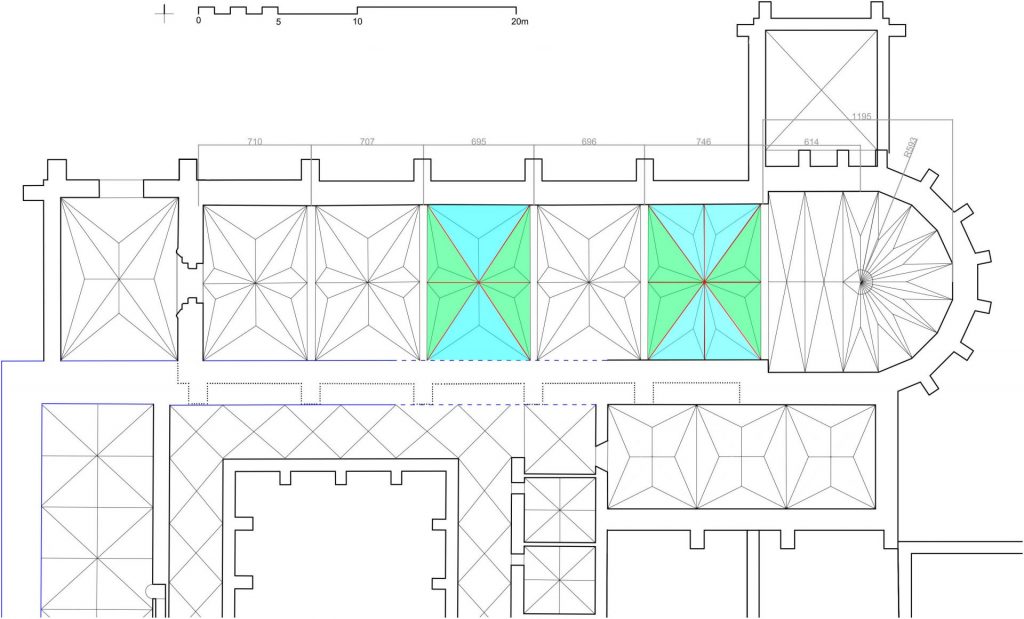
The purpose of this design variation emerges clearly only when the interior is observed from the westernmost bay. As discussed above, the space in the church opened to the faithful. Indeed, looking from this standpoint, the eastern bay vault seems to be similar to the other vaults of the nave. It suggests that Simón manipulated the vault plan so that the nave’s inner space appeared from the perspective of the faithful as a unitary space, an optical illusion that Simón de Colonia shaped by displacing the position of the bosses from the transversal axis (see Fig. 9.16).
Conclusions
At the request of Isabella I of Castile, Simón de Colonia modified the church of the charterhouse of Miraflores, as designed by his father in the 1450s. All the evidence suggests that the queen did not consider the original church’s plain style appropriate for a royal foundation. Besides a clear stylistic paradigm shift, Simón de Colonia’s architecture reveals a thoughtful reflection on the perception of architectural spaces and forms, in which the potential viewpoint of the beholder played a key role. In other words, Simón conceived his architecture to be seen from key viewpoints, both within the church and outside it. If his father’s design largely imitated the plan and vocabulary of Santa María de las Cuevas, Simón invented new modifications to the church at Miraflores, creating subtle visual illusions and radically new aesthetic effects.
Citations
[1] See Luciano Serrano, Los Reyes Católicos y la ciudad de Burgos (Desde 1451 a 1492) (Madrid: Consejo Superior de Investigaciones Científicas, Instituto Jerónimo Zurita, 1943), pp. 142-66.
[2] ‘E luego el bastardo hermano del Rey, y el Condestable, escribiéron á la Reyna que estaba en Valladolid, que veniese á asentar el partido, é á recebir su fortaleza. La Reyna vistas las letras del Duque é del Condestable, partió de Valladolid, é vino para la cibdad de Búrgos, é posó en las casas del Obispo. É allí viniéron á ella personas diputadas por parte del Alcayde, é de los que estaban con él en el castillo: é perdonólos, é mandóles restituir sus bienes, é recibió el castillo, en el qual puso por Alcayde á Diego de Ribera, Ayo que fué del Príncipe Don Alonso su hermano: é dió órden en el bastimento é reparo del castillo, y en la justicia, é guarda de la cibdad. Esto fecho, volvió luego para Valladolid, é dende vino para Tordesillas, por estar mas cerca de Toro é de Zamora para proveer las cosas necesarias á la guerra’. Hernado del Pulgar, Crónica de los Señores Reyes Católicos Don Fernando y Doña Isabel de Castilla y de Aragón, escrita por su cronista Hernando del Pulgar cotexada con antiguos manuscritos y aumentada de varias ilustraciones y enmiendas (Valencia: Imprenta de Benito Monfort, 1780), p. 74.
[3] Franciso Tarín y Juaneda, La Real Cartuja de Miraflores (Burgos). Su historia y descripción (Burgos: Hijos de Santiago Rodríguez, 1897), pp. 138-9.
[4] Tarín y Juaneda, La Real Cartuja, pp. 138-39; Ronda Kasl, The Making of Hispano-Flemish Style. Art, Commerce, and Politics in Fifteenth-Century Castile (Turnhout: Brepols Publishers, 2014), pp. 107-8.
[5] ‘76.- A 23 de Abril confirmaron todos los privilegios los Reyes Don Fernando y Doña Ysabel’. Noticia vreve y compendiosa de la fundacion desta Real Cartuja de Miraflores sacada del Libro del Becerro, con otras noticias dignas de saberse (hereafter Noticia vreve), Carpeta 377, Documento 6, Archivo Cartuja de Miraflores (hereafter ACM).
[6] ‘A 26 de Febrero se volvio a proseguir la obra de la iglesia’. Noticia vreve, ACM. The date given in the Noticia vreve as the start of works seems to refer to the ceremony.
[7] ‘Año de 1476 junto con su Marido Don Fernando el Catolico confirmo todos los privilegios de esta Casa, y despues año de 1477 mando proseguir la fabrica de la Yglesia’. Breve noticia de la fundacion de la Real Cartuja de Miraflores, Proyecto de continuación de la España Sagrada, Documento 1, Real Academia de la Historia.
[8] Juan Arias de Miranda, Apuntes históricos sobre la Cartuja de Miraflores, de Burgos (Burgos: Imprenta de Pascual Polo, 1843), p. 39; Manuel de Assas y Ereño, La Cartuja de Miraflores, junto á Burgos (Madrid: José Gil Dorregaray, 1880), p. 21; Kasl, The Making of Hispano-Flemish Style, p. 108.
[9] Noticia vreve, ACM; Tarín y Juaneda, La Real Cartuja, pp. 124, 153.
[10] The first recorded spending by the Crown for Miraflores dates from 1480. See Miguel Ángel Ladero Quesada, La hacienda real castellana entre 1480 y 1492 (Valladolid: Universidad de Valladolid, 1967), p. 73.
[11] Miguel Ángel Ladero Quesada, La España de los Reyes Católicos (Madrid: Alianza Editorial, 2015), p. 64.
[12] See Eduardo de Oliver-Copons, El Castillo de Burgos (Barcelona: Imprenta de Henrich y Compla en Comandita, 1893), pp. 200-4.
[13] Fundacion de la Cartuja de Burgos (hereafter Fundacion de la Cartuja), Carpeta 377, Documento 1, fol. 1v, ACM; Inuentario del Archivo Común y Cofre del Cid, Cartuja de Miraflores (hereafter Cartuja de Miraflores), fol. 321v, Archivo Histórico de la Catedral de Burgos (hereafter ACB). For Juan de Colonia’s biography and work, see Manuel Martínez y Sanz, Historia del templo catedral de Burgos (Burgos: Imprenta de don Anselmo Revilla, 1866); Carl Justi, ‘Die kölnischen Meister an der Kathedrale von Burgos’, Jahrbücher des Vereins von Alterthumsfreunden in Rheinlande 93 (1892): pp. 1-30; Vicente Lampérez y Romea, ‘Juan de Colonia. Estudio biográfico-crítico’, Boletín de la Sociedad Castellana de Excursiones 19 (1903): pp. 351-356 and 22 (1904): pp. 403-415; Hugo Kehrer, ‘Die Türme der Kathedrale von Burgos und Hans von Köln’, Münchner Jahrbuch der bildenden Kunst 4 (1928): pp. 477-489; August Liebmann Mayer, Gotik in Spanien (Leipzip: Klinkhardt & Biermann Verlag, 1928), pp. 31-4; Teófilo López Mata, La catedral de Burgos (Burgos: Hijos de Santiago Rodríguez, 1950); Matías Martínez Burgos, ‘En torno a la catedral de Burgos. II Colonias y Siloes. Juan de Colonia’, Boletín de la Institución Fernán González 128 (1954): pp. 215–226; Nicolás Menéndez González, ‘Juan de Colonia en los inicios del tardogótico burgalés’, in Juan Francisco Jiménez et al. (eds.), Actas IV Simposio de Jóvenes Medievalistas. Lorca 2018 (Murcia: Universidad de Murcia, 2009), pp. 145-160; María Pilar García Cuetos, ‘En los límites de la sombra como arquetipo historiográfico. La llegada de Juan de Colonia y su aportación a la arquitectura tardogótica en Castilla’, in Begoña Alonso Ruiz (coord.), Los últimos arquitectos del Gótico (Madrid: Grupo de Investigación de Arquitectura Tardogótica, 2010), pp. 71-146; Nicolás Menéndez González, ‘Juan de Colonia and the west façade of Burgos cathedral: 1442-1458’, Hortus Artium Medievalium 16 (2010): pp. 333-339; Nicolás Menéndez González, ‘Ecclesia ecclesiarum et civitas civitarum Castelle. La instrumentalización retórica de la arquitectura en la obra política de Alonso García de Santa María’, in María Dolores Teijeira Pablos, María Victoria Herráez Ortega and María Concepción Cosmen, Reyes y prelados. La creación artística en los reinos de León y Castilla (1050-1500) (Madrid: Sílex, 2014), pp. 371-388; Nicolás Menéndez González, Studien zum empirischen Konstruieren Juan de Colonias († 1476/78). Form- und Herstellungswissen im Protostadium einer Ära des Architekturtraktats, 2 vols. (Cologne: Kölner Architekturstudien, 2018), and for his death, see 1: pp. 83-6.
[14] Noticia vreve, ACM; Arias de Miranda, Apuntes históricos, p. 39; Tarín y Juaneda, La Real Cartuja, p. 145.
[15] Fundacion de la Cartuja, fol. 1v, ACM; Cartuja de Miraflores, fol. 321v, ACM.
[16] Noticia vreve, ACM; Noticia breve y compendiosa de la fundacion de esta Real Cartuja de Miraflores, sacada del libro de Becerro, con otras noticias dignas de saberse (hereafter Noticia breve), Cuaderno 375, fol. 19, ACM.
[17] See Arias de Miranda, Apuntes históricos, p. 39; Juan de Dios de la Rada y Delgado, ‘Sepulcro de Don Juan II en la Cartuja de Miraflores de Burgos’, Museo español de antigüedades 3 (1874): p. 302; Manuel de Assas y Ereño, La Cartuja de Miraflores, junto á Burgos (Madrid: José Gil Dorregaray, 1880), p. 21; Tarín y Juaneda, La Real Cartuja, p. 145; Kasl, The Making of Hispano-Flemish Style, p. 108; Begoña Alonso Ruiz, ‘Las capillas funerarias de los Trastámara: de la creación de la memoria a “la grandeza humillada”’, in Olga Pérez Monzón, Matilde Miquel Juan and María Martín Gil (eds.), Retórica artística en el tardogótico castellano. La capilla fúnebre de Álvaro de Luna en contexto (Madrid: Sílex, 2018), p. 157.
[18] Transcribed by Tarín y Juaneda, La Real Cartuja, pp. 562-4.
[19] The south wall was a remnant of the old palace built by king Enrique III of Castile. On the palace of Miraflores, see Luciano Huidrobro y Serna, ‘El antiguo palacio real de Miraflores’, Boletín de la Comisión Provincial de Monumentos Históricos de Burgos 14 (1935): pp. 209-14.
[20] On this procedure in Miraflores’s cloisters, see Menéndez González, Studien zum empirischen Konstruieren Juan de Colonias, 2: pp. 137-54.
[21] For Astorga Cathedral, see Pablo de la Riestra, La catedral de Astorga y la arquitectura del gótico alemán (Oviedo: Museo de la Catedral de Astorga, 1992); Pablo de la Riestra, ‘La catedral de Astorga y sus referentes alemanes’, in Christian Freigang (ed.), Gotische Architektur in Spanien. La arquitectura gótica en España (Frankfurt am Main and Madrid: Iberoamericana Vervuert, 1999), pp. 273-288. For Seville Cathedral, see Alonso Jiménez Martín (ed.), La piedra postrera, 2 vols. (Seville: Tvrris Fortíssima, 2007); Juan Clemente Rodríguez Estévez, ‘Cambio y continuidad en el proyecto gótico de la catedral de Sevilla’, Laboratorio de Arte 23 (2011): pp. 33-64; Alfonso Jiménez Martín: Anatomía de la catedral de Sevilla (Seville: Diputación de Sevilla, 2013).
[22] See Matías Martínez Burgos, ‘Don Alonso de Cartagena, obispo de Burgos. Su testamento’, Revista de Archivos, Bibliotecas y Museos 63 (1957): p. 91.
[23] Noticia vreve, ACM; Tarín y Juaneda, La Real Cartuja, p. 143.
[24] ‘85. se puso el lazo, o clarauoia en el obalo de la yglesia encima de la puerta’. Noticia vreve, ACM.
[25] For the two groups of stained glass in the church of Miraflores, see Jan van Damme, ‘Niclaes Rombouts y las vidrieras de la Cartuja de Miraflores’, in La Cartuja de Miraflores, vol. 3, Las vidrieras (Madrid: Fundación Iberdrola, 2007), p. 52. Scholars normally date the commission of the stained glass to ca. 1482-84: Assas y Ereño, La Cartuja, p. 21; Fernando Cortés Pizano, ‘Vidrieros de los Paises Bajos en España’, in La Cartuja de Miraflores, 3: pp. 20-22; van Damme, ‘Niclaes Rombouts’, pp. 41-53; Kasl, The Making of Hispano-Flemish Style, pp. 21-4. However, the first payment for the acquisition of the stained glass in Flanders dates to 1486. Two other payments were made in 1487 and 1488: ‘Dieronse Diego de Soria un gran mercader de Burgos para que comprase en Flandes las vidrieras de la iglesia el año 1486 26.500’, Cartuja de Miraflores, fol. 322, ACB.
[26] Joaquín Yarza Luaces, Los Reyes Católicos. Paisaje artístico de una monarquía (Madrid: Nerea, 1993), pp. 54-64.
[27] On the tombs, see María Jesús Gómez Bárcena, Escultura gótica funeraria en Burgos (Burgos: Diputación Provincial de Burgos, 1988) pp. 203-21; Joaquín Yarza Luaces, Los Reyes Católicos, pp. 59-64; Joaquín Yarza Luaces, ‘Los sepulcros reales de la Cartuja de Miraflores’, in La Cartuja de Miraflores, vol. 1, Los Sepulcros (Madrid: Fundación Iberdrola, 2007), pp. 15-73; Kasl, The Making of Hispano-Flemish Style, pp. 122-53. For the tomb of John II and Isabella of Portugal, see Felipe Pereda, ‘El cuerpo muerto del rey Juan II, Gil de Siloé, y la imaginación escatológica (Observaciones sobre el lenguaje de la escultura en la alta Edad Media)’, Anuario del Departamento de Historia y Teoría del Arte (U.A.M.) 13 (2001): pp. 53-85. For the tomb of the Infante Alfonso, see María Jesús Gómez Bárcena, ‘El sepulcro del Infante Alfonso’, in Actas del Congreso Internacional sobre Gil de Siloe y la escultura de su época (Burgos, Institución Fernán González, 2001), pp. 189-206; María Dolores Teijeira Pablos: ‘Un ejemplo de iconografía marginal funeraria: la orla del sepulcro del infante Alfonso en la Cartuja de Miraflores’, Reales Sitios 133 (1997): pp. 35-43.
[28] For Simón de Colonia’s biography and work, see Martínez y Sanz, Historia del templo catedral; Justi, Die kölnischen Meister; Mayer, Gotik in Spanien, pp. 150-167; Filemón Arribas Arranz, ‘Simón de Colonia en Valladolid’, Boletín del Seminario de Estudios de Arte y Arqueología 11 (1933-4): pp. 153-166; López Mata, La catedral de Burgos; Matías Martínez Burgos, ‘En torno a la catedral de Burgos. II. Colonias y Siloes. Juan y Simón de Colonia.- Gil de Siloe’, Boletín de la Institución Fernán González 130 (1955): pp. 433–459; Rafael Domínguez Casas, Arte y etiqueta de los Reyes Católicos. Artistas, residencias, jardines y bosques (Madrid: Editorial alpuerto, 1993), pp. 51-7; Felipe Pereda and Alfonso Rodríguez G. de Ceballos, ‘Coeli enarrant gloriam dei. Arquitectura, iconografía y liturgia en la capilla de los Condestables de la Catedral de Burgos’, Annali di architettura: rivista del Centro Internazionale di Studi di Architettura 9 (1997): pp. 17–34; Isidro Gonzalo Bango Torviso, ‘Simón de Colonia y la ciudad de Burgos. Sobre la definición estilística de las segundas generaciones de familias de artistas extranjeros en los siglos XV y XVI’, in: Actas del Congreso Internacional sobre Gil de Siloe y la escultura de su época (Burgos, Institución Fernán González, 2001), pp. 51-69; Felipe Pereda, ‘La morada del salvaje. La fachada selvática del colegio de San Gregorio y sus contextos’, in Begoña Alonso Ruiz (coord.), Los últimos arquitectos del Gótico (Madrid: Grupo de Investigación de Arquitectura Tardogótica, 2010), pp. 149–217; Menéndez González, Studien zum empirischen Konstruieren Juan de Colonias; Nicolás Menéndez González, ‘Una traza original de Simón de Colonia procedente de la Cartuja de Miraflores (Observaciones sobre las estrategias del diseño arquitectónico en el Cuatrocientos hispano)’, Medievalia 22 (forthcoming).
[29] Menéndez González, Studien zum empirischen Konstruieren Juan de Colonias, 2: pp. 172-88. Following the chronicles, it has been hitherto assumed that Garci Fernández de Matienzo and Simón de Colonia had continued construction of the church following Juan de Colonia’s designs. See Arias de Miranda, Apuntes históricos, p. 39; Rada y Delgado, Sepulcro de Don, pp. 302-3; Assas y Ereño, La Cartuja, p. 21; Tarín y Juaneda, La Real Cartuja, p. 145.
[30] ‘[1486] Se hizo la capilla á la entrada de la iglesia con una portada magnifica: en ella se colocó una estatua de la Compasion de Nuestra Señora, y un óvalo pequeño en frente de la puerta de la iglesia. Esto se mudó por los años de 1658, como se dirá’. Noticia breve, fols. 21-2, ACM. Indeed, the portal was dismantled and moved to its current location under prior Juan de Santoya (1648-1661), as part of an extensive renewal programme of the church: ‘El año de [16]57 se empezó á componer la iglesia; se blanqueó toda; se hizo la cornisa, la que se construyó sobre la que tenia, que apenas se divisaba: se pusieron todos los Cuadros con sus adornos, y cuatro vidrieras de la capilla mayor; óvalo de la iglesia: se abrio el óvalo que está sobre la puerta de la iglesia, y se le puso vidriera; / se muda la puerta: se mudó la puerta primera del lado del regañon, á donde está ahora; y el óvalo pequeño que estaba donde está la puerta, se puso donde estaba antes la puerta.’ Noticia breve, fols. 41-2, ACM. The main portal had been relegated to a second plane since the 1530s by the construction of chapels on the church’s north side and the gatehouse.
[31] Clero regular, Carpeta 259, Legajo 6, Archivo Histórico Nacional (hereafter AHN). On this architectural drawing, see Menéndez González, Studien zum empirischen Konstruieren Juan de Colonias, 2: pp. 189-204; Nicolás Menéndez González, Una traza original de Simón de Colonia.
[32] See Menéndez González, Studien zum empirischen Konstruieren Juan de Colonias, 2: pp. 112-33.
[33] As is clear from the letter from John II to the Prior General of the Order, Francisco Maresme, in which he formally offered the palace’s donation and the monastery’s foundation: ‘nos place de ofrecer a la dicha buestra horden los nuestros Palacios de Miraflores, que son situados cerca de la nra. mui noble Cibdad de Burgos caveza de Castilla nuestra Cámara que es a media legua de la dicha Cibdad. E si por ventura los dichos Palacios al modo de la dicha horden non pudieren asi ser dispuestos a nos placera con consejo de Personas de la dicha horden mandar construir e facer fuera de los dichos Palacios celdas para doce Monjes e ocho hermanos legos, e asi mesmo entendemos edificar Iglesia e Claustro e oficinas al modo de la dicha horden’. Tarín y Juaneda, La Real Cartuja, p. 532.
[34] On the transfer of architectural models from Seville to Miraflores, see Menéndez González, Studien zum empirischen Konstruieren Juan de Colonias, 2: pp. 116-33.
[35] Tarín y Juaneda, La Real Cartuja, p. 101.
[36] See Francisco de Paula Cañas Gálvez, El itinerario de la corte de Juan II de Castilla (1418-1454) (Madrid: Sílex, 2007).
[37] Kasl, The Making of Hispano-Flemish Style, p. 107; Menéndez González, Studien zum empirischen Konstruieren Juan de Colonias, 2: pp. 100-1.
[38] The stonecutting technique is more precise in the Constable’s Chapel, where the pieces were elaborated with accurate, sharp edges and intersections. The mouldings are also decorated with vegetable ornament.
[39] For San Pedro de Cardeña, see Menéndez, Studien zum empirischen Konstruieren Juan de Colonias, 1: pp. 135-45.
[40] Miraflores’ main chapel vault repeats the form of Nuestra Señora de las Cuevas. That is the reason why we can assume that this form goes back to the vault plan devised by Juan de Colonia.
[41] This analysis refutes the historiography concerning the authorship of Miraflores vault plan. The attribution of the vaults of the capilla mayor to Simón de Colonia on account of their tracery decoration, and those the nave to his father, is unconvincing. See Elena Martín Martínez de Simón, ‘Arquitectura religiosa tardogótica en la provincial de Burgos (1440-1511)’ (PhD diss., Universidad de Burgos, 2013), p. 1191; Alonso Ruiz, Las capillas funerarias, p. 157.
[42] Gracia y Justicia, Legajos, 00194, Archivo General de Simancas. See Sec. Consejos, Mapa no. 760, AHN; Sec. Consejos, Mapa no. 761, AHN. Both are reproduced in Burgos. La ciudad a través de la cartografía histórica (Burgos: Instituto Municipal de Cultura, 2002), pp. 98-9.
[43] The portal has been located on the wall adjacent to the church’s sacristy since 1956.
[44] See B. de A., La Cartuja de Miraflores (Burgos: Hijos de Santiago Rodríguez, 1899), p. 10.
[45] In 1657 the rose was relocated on north side of the narthex. See note 30.
[46] See Elena Paulino Montero, ‘“Ea quae insignite fiunt sepulcra mortuorum”. La capilla de la Purificación de la catedral de Burgos y la creación de la memoria’, in Olga Pérez Monzón, Matilde Miquel Juan and María Martín Gil (eds.), Retórica artística en el tardogótico castellano. La capilla fúnebre de Álvaro de Luna en contexto (Madrid: Sílex, 2018), p. 247.
[47] Tarín y Juaneda, La Real Cartuja, pp. 328-9; Isidro Gonzalo Bango Torviso, Edificios e imágenes medievales. Historia y significado de las formas (Madrid: Historia 16, 1995), pp. 85-7.
[48] Noticia breve, fol. 44, ACM.
[49] ‘este año [1493] se concluio la reja de la yglesia, que divide el coro de los conversos, y seculares’. Noticia vreve, ACM. ‘Los Angeles que habia en la reja grande, y tenían dos caras la una de hombre y la otra de mujer, los hizo el Maestro Gil, (el mismo que hizo los sepulcros) y costaron 16.000 maravedíes’. Noticia breve, fol. 44, ACM.
[50] As recorded in the Memorial del plan y obras: ‘E en la nave de la yglesia deve aver a lo menos quatro cruseros | de los quales los dos cruseros que son mas cercanos a la capilla an de ser coro de los monges. E el tercero crusero ha de ser coro de los frayles barbudos. El cuarto para los seglares.’ Transcribed by Tarín y Juaneda, La Real Cartuja, p. 562. Nevertheless, the nave was built with five bays.
DOI: 10.33999/2019.53
